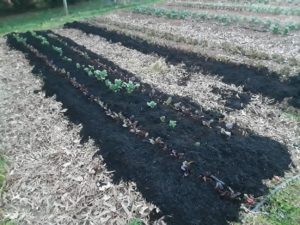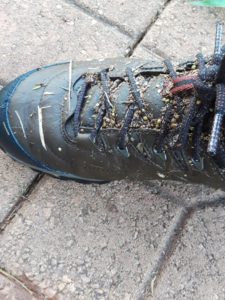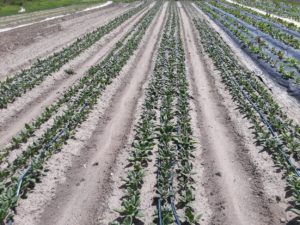Homesteading – Manage Weeds While Building Soils
go.ncsu.edu/readext?581856
en Español / em Português
El inglés es el idioma de control de esta página. En la medida en que haya algún conflicto entre la traducción al inglés y la traducción, el inglés prevalece.
Al hacer clic en el enlace de traducción se activa un servicio de traducción gratuito para convertir la página al español. Al igual que con cualquier traducción por Internet, la conversión no es sensible al contexto y puede que no traduzca el texto en su significado original. NC State Extension no garantiza la exactitud del texto traducido. Por favor, tenga en cuenta que algunas aplicaciones y/o servicios pueden no funcionar como se espera cuando se traducen.
Português
Inglês é o idioma de controle desta página. Na medida que haja algum conflito entre o texto original em Inglês e a tradução, o Inglês prevalece.
Ao clicar no link de tradução, um serviço gratuito de tradução será ativado para converter a página para o Português. Como em qualquer tradução pela internet, a conversão não é sensivel ao contexto e pode não ocorrer a tradução para o significado orginal. O serviço de Extensão da Carolina do Norte (NC State Extension) não garante a exatidão do texto traduzido. Por favor, observe que algumas funções ou serviços podem não funcionar como esperado após a tradução.
English
English is the controlling language of this page. To the extent there is any conflict between the English text and the translation, English controls.
Clicking on the translation link activates a free translation service to convert the page to Spanish. As with any Internet translation, the conversion is not context-sensitive and may not translate the text to its original meaning. NC State Extension does not guarantee the accuracy of the translated text. Please note that some applications and/or services may not function as expected when translated.
Collapse ▲Weed management is one of the biggest challenges in any agricultural endeavor.
Weeds suck nutrients, water, and light from crops. Weeds host diseases and insects. Some weeds are poisonous. Weeds reduce ventilation, thus increasing foliar fungal disease in crops. Weed do a lot of damage but perhaps worst of all, weeds sap energy and enthusiasm. I have heard from many folks that quit
homesteading because managing weeds was too difficult. Weed management requires a strategy based on many little hammers – lots of small practices and tools that add up to an accumulative effect that keeps weed levels under control. Follow these 4 weed management tips and you can win the war on weeds.
Tip #1 – Don’t bring weeds into your garden:
Be judicious about materials that you put into your garden bed. Some top soil mixes contain weed seeds. Some manures (especially horse manure) can introduce new weeds to your production system. Do you know the difference between hay and straw? Straw is typically the stem material from a wheat or small grain harvest. Straw is not guaranteed free of weed seeds but it will be much better than hay. Hay is the cut biomass in a pasture. Depending on the pasture management and the time of cutting you could have thousands of seed heads from dozens of plants that you don’t want growing in your vegetable beds.
Tip #2 – Keep the soil covered:

This bed of beets, greens, and potatoes will be almost weed free with this 3 inch covering of leaf compost.
Keeping soil covered is a simple axiom for minimizing weeds. You can keep the soil covered with organic matter such as a vigorously growing crop, cover crops, and mulch (leaf compost, wood chips, paper, cardboard, leaves, or crop residue). You can also keep the soil covered with synthetic matter like black plastic, tarps, landscape fabric, or other materials. Both organic and synthetic options have pros and cons. Both types should be considered in a good weed management program. This is also a good place to mention cover crops. There are lots of great cover crop options for keeping your soil covered in the summer and winter. One of our key cover crops is crimson clover. In the past we have used the stand by variety Dixie. However, this article has compelled me to try Kentucky Pride Crimson Clover.
Tip #3 – Kill weeds early:
The bigger they get the harder they are to kill and the more damage they cause. The ideal time to kill weeds is when they are in the white thread stage, that is when the weed seed has germinated but it has not yet emerged. These are weeds that you cannot see. The term ‘blind cultivation’ is used to describe using tools like flex tine harrows that you drag over a planted bed. Each flex tine is shattering hundreds if not thousands of tiny white thread weeds that we will never see. However, when you compare planted beds that have been flex tine harrowed at least two times compared to planted beds with no harrowing, the difference in weed density is dramatic. Blind cultivation is one of the most effective ways to kill weeds.
Tip #4 – Follow tips 1 through 3 or . . . you have to kill big weeds!
Killing weeds that escaped blind cultivation is the next prong of a full weed-management program. There are many options depending on producer preferences, crop, and equipment in the field such as drip irrigation. Some of the basic categories of tools involve mechanical, chemical, fire, or electrical control.
Mechanical: There are a variety of specialty hoes such as diamond head hoes, cobra head hoes, swan neck hoes, stirrup hoes, collinear hoes, heron hoes, and more.
Fire: It’s hard not to have fun torching weeds. Fast moving flamers quickly damage growing points without the need to hover flames over the weed for several seconds. This is effective when weeds are small.
Chemical: Chemical weed control can make a big difference for growers. Even if you are a low spray homesteader like me, a single spray of a grass-killing herbicide can save a crop and save you dozens of hours of back-breaking hoeing. Burndown herbicides – chemicals that damage any plant that they contact – can help clean up your production area before planting or in-season with careful spot spraying. Round Up is the most well-known burndown herbicide. There are burndown herbicides that are labeled for organic production as well.
Electrical: There is a new wave of technology exploring killing weeds with electrical current. I have not seen options for small scale production but it is an alternative management option to be aware of.
Catawba County Gardening Homepage
Annual Garden Calendar for Catawba County
Project Homestead – Grow Your Own Food on Less than 1 Acre in Catawba County
Homesteading – Eat a Salad From Your Garden Everyday
Homesteading: Grow Your Own Food – Planting Schedule







